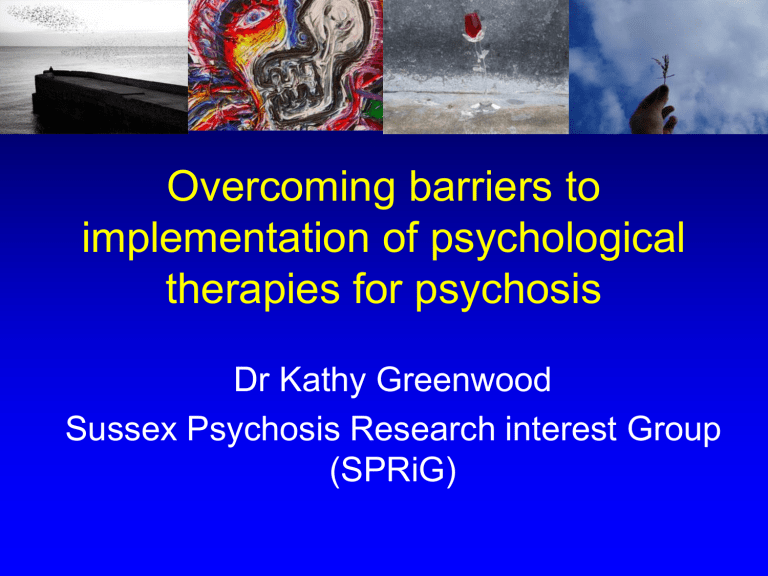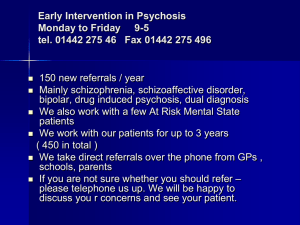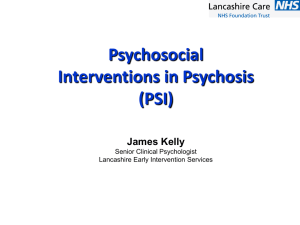sprig 2015 implementing psychological therapies for psychosis what27s stopping us (4)

Overcoming barriers to implementation of psychological therapies for psychosis
Dr Kathy Greenwood
Sussex Psychosis Research interest Group
(SPRiG)
CBTp RCTs – meta-analysis
(Wykes et al, 2008,
Schizo Bull
, 34, 523-37)
Effect sizes of 33 trials
2.5
2
1.5
1
0.5
0
-0.5
-1
Mean effect size on target symptoms: .40 (95% CIs: .25 - .55)
“Rigorous” studies only: (12 studies): .22 (95% CIs: .02 - .43)
CBTp RCTs* – meta-analysis
(Wykes et al, 2008,
Schizo Bull
, 34, 523-37)
• Significant effects (ranging from .35 – .44
) for:
• Positive symptoms (32 studies)
• Negative symptoms (23 studies)
• Functioning (15 studies)
• Mood (13 studies)
• Social anxiety (2 studies)
*20 from UK, 5 from USA, 2 from Germany, Australia, Netherlands, 1 from Canada, Italy,
Israel; 27 individual CBTp, 7 group CBTp
Practitioners, people using
Services and families highlighted the interventions most valued alongside medication.
43% CBT.
(only 10% among service users).
The most researched therapy is (CBT). Trials have found that on average, people gain as much benefit from CBT as from medication.
‘Family interventions’ have also been extensively researched and many people find family meetings very helpful.
CBTp is effective:
• 1% of the UK population (approximately 600,000 people) have psychosis
• 40% have persistent distressing symptoms (5200-
8600 in Sussex alone)
• CBTp is the only NICE recommended individual intervention for psychosis
• Multiple RCT’s and meta-analyses support its effectiveness
So what’s the problem?
• 94% of trusts struggle to provide CBTp.
• Fewer than 20% of service-users receive it
• Of 187 randomly selected service users in NW
England only 13 (6.9%) had been offered
CBTp
Haddock et al. 2013
• Of those offered it, 22-43% refuse or do not attend
(Freeman et al. 2013; Haddock et al. 2013)
Implementation research
• Planning
• Educating
• Financing
• Restructuring
• Monitoring Quality
• Policy content
Powell et al. 2012
Investment and Access?
Talking therapy: demand vastly outstrips supply in the NHS.
Urgent need for further investmen t in psychological approaches to ensure that all services come up to the standard of the best, and so that people can be offered choice.
Different approaches suit different people. Not everyone finds formal psychological therapy helpful, some find it unhelpful.
All staff need to be trained in the principles of a psychological approach so that it can inform not only formal therapy but also the whole culture of services and every conversation that happens within them.
Only 1 in 10 of those who could benefit get access to true CBT (Cognitive
Behavioural Therapy) despite it being recommended by
NICE (National Institute of
Health and Clinical Excellence).
• Increase access to
psychological therapies in line with NICE guidelines.
• Ensure commissioning of services in line with NICE
Improving capacity to meet demand
(Garety and colleagues)
• Mental health, learning disabilities and addictions services; national specialist services; large R&D portfolio. 4,500 staff
• Core population - 4 South London Boroughs
1.1million; inner city, very high indices of social deprivation
• Substantially raised rates of psychosis, especially in ethnic minority populations (x4-
9)
Conclusions
(Prytys et al 2011)
• Mapping of need
– 10 point charter
– Named link person in each team
– Screening for CBT/FI eligibility
– Training for staff
• Limited change in implementation
Conclusions
(Prytys et al 2011)
• Audited provision remained low around 10% for CBTp and 5% for FIp.
• •Barriers to implementation included pessimistic staff views (on recovery), misunderstanding of who was suitable for psychological therapy, heavy caseload, and pressure of ‘other tasks’.
• •Need for highly trained and supervised staff.
• •No funding for implementation
So what’s stopping us?
Cost and Access or
A war of words, beliefs and ideologies?
Words, Beliefs, Ideologies?
Knowledge and beliefs are important
• NICE - research aimed at behaviour change
(individuals or population) needs to consider knowledge and beliefs
• Theory of planned behaviour - requires implementation is desirable, associated with positive attitudes and perceived to be within behavioural control (Ajzen 1991).
Knowledge and beliefs are important
• Conceptual models of implementation require change in the ‘adopter’ needs, motivations, values, goals and skills
– perceived relative advantage (compared with other approaches),
– compatibility with self (one’s own views, health and illness perceptions)
– complexity, trialability and observability (i.e. seeing it as achievable, watching it in action and knowing that it works )
Barriers to implementation
What CMHT staff say?
Questions
What is your understanding of the outcomes of people with schizophrenia?
How do you work with people with a diagnosis of schizophrenia?
How would you prioritise which service users are offered therapy?
Are you aware of the NICE guidelines for schizophrenia regarding psychological therapies?
What are your views about clinical practice guidelines such as NICE?
Prytys et al. 2010
What CMHT staff say?
Prytys et al. 2010 (n=20)
16 concerned by lack of time ‘the focus became more on keeping them stable … with just compliance with medication , very little support
.
10 emphasised combined medication and therapy ‘They have to be on their medication obviously. If they don’t take their medication it (therapy) is not going to work ’
What CMHT staff say?
Prytys et al. 2010 (n=20)
7 positive and 6 negative views re. CBTp benefits - thought for high fx less symptomatic.
10 reported service user refusal ‘I don’t think they would ask for it’
13 thought simple CBT techniques important e.g
psychoeducation, anxiety management, relapse prevention
11 emphasised importance of specialist CBT therapist in team or lack of this as a barrier to intervention.
What CMHT staff say?
Beliefs about referral criteria, pathways, benefits
• Insight – High and Low
• Symptoms – High and Low
• Function – High and Low
Uptake?
What EYE project service users say..
• Informed choice, holistic approaches, availability of talking therapies are facilitators to engagement
• Exclusive focus on medication, lack of choice, lack of information are barriers
• Uptake/engagement with psychosis interventions hampered by beliefs & emotional barriers
(Greenwood et al. in prep; Morrison et al. 2012)
Uptake
• Uptake of interventions/CBTp affected by health, illness and treatment perceptions.
• Beliefs that psychosis is transitory led to reduced uptake
• Beliefs of limited personal control and biological causality (control/cure) led to reduce active engagement
• Limited illness beliefs explored
(Freeman et al. 2013; 2014; Williams and Steer 2011; Theodore et al. 2012; Lobban et al. 2004).
Illness Perception
(e.g. Rogers 1983)
Protection Motivation Theory
THREAT
APPRAISAL
PERCEIVED
VULNERABILITY
INFORMATIONAL
INPUTS
PERCEIVED
SEVERITY
COPING
APPRAISAL
SELF-EFFICACY
(PROTECTIVE)
BEHAVIOUR
(Threat minimised)
RESPONSE
EFFICACY
Uptake Interventions
• Specific (pre-) interventions, based on illness perceptions, have been effective in promoting adherence to and outcomes from physical health interventions and have emphasised the need to tailor the intervention to health beliefs.
• Interventions for medication adherence in psychosis are also common, with medication adherence relating to beliefs about treatment and illness perceptions.
Cameron et al 2005; Horne and Weinman et al 2002;
McAndrew et al. 2008; Petrie et al. 2002
Recent key CBTp studies
• Turner et al 2014
Psychological Interventions for Psychosis: A Meta-
Analysis of Comparative Outcome Studies
• Jauhar et al 2014
Cognitive-behavioural therapy for the symptoms of schizophrenia: systematic review and meta-analysis with examination of potential bias
• Morrison et al 2014
Cognitive therapy for people with schizophrenia spectrum disorders not taking antipsychotic drugs: a single-blind randomised controlled trial
"This house believes that CBT for psychosis has been oversold"
Only 1 in 10 of those who could benefit get access to true CBT despite it being recommended by NICE
(National Institute of
Health and Clinical
Excellence).
The basis of clinical decisions
Isaacs and Fitzgerald BMJ 1999
• Eminence
– seniority of the protagonist with a faith in clinical experience
• Vehemence
– Volume substitutes for evidence
• Eloquence
– Good dress sense and verbal skill
• Confidence
– Only applicable to surgeons
• Evidence
– Randomised controlled trials, meta-analyses
IAPT for Psychosis:
Northwest Sussex Pilot
Dr Emily Gray, Principal Clinical Psychologist
Dr Nicola Motton, Clinical Psychologist
Northern West Sussex Assessment and
Treatment Service
Daniel Stevens, Assistant Psychologist
Education and Training
With thanks to Jenefer Lofty, Art Therapist, and Esmie Rush, Psychology Intern,
Northwest Sussex Assessment and Treatment Service
Increase capacity to offer therapy in Northwest Sussex
• Art Therapy (group format)
• CBT
• Family Intervention (FI)
• Behavioural Activation / Graded
Exposure (BA/GE)
Increase capacity to offer therapy:
Our approach
• Use existing resource – designated
“psychosis spaces” on caseloads
• -New training for existing staff to increase capacity (FI, BA/GE)
• -Top-up training for CBT practitioners
• -Specialist supervision – CBT and FI
• Additional resource - Assistant psychologists
(BA/GE) and CBT trainees
Training outcomes
• 10 members of staff trained in BA/GE to date;
• 2 currently in training
• 6 members of staff trained in FI to date;
• 2 currently in training
Increasing offers of therapy
• So through increasing capacity as described above, did the number of offers of therapy increase?
• A target of 82 offers of therapy was set (half of the caseload at baseline who were identified as having schizophrenia-spectrum disorders)
• Criteria for identifying appropriate clients to different interventions were circulated, clinicians attended team meetings, circulated emails advertising psychosis spaces
Offers of therapy made:
• There have been 67 new offers of therapy since Dec
2012 (approx 42% of those with schizophrenia spectrum disorders on caseloads)
• 82% towards our target of making 82 new offers of therapy within 2 year period
What helped increase offers?
• Use of groups enabled a greater number of clients to receive art therapy
• Positive experience of interventions from staff perspective more referrals
• Staff valued opportunities to discuss potential referrals, availability of therapy staff and approachability
• Increased conversations between clinicians, and between clinicians and clients about interventions
Challenges
• Movement of staff
• Competing time demands
• Competing clinical demands
(complex trauma/PD
– also CBT slots are only 2.5% of case load)
• Difficulty identifying appropriate clients
(insight, medication, stability)
• Clinicians’ perceptions of capacity and referral process
• Clinicians’ knowledge of treatment options, benefits, pathways
Ideas going forwards
• Improve information for clients and staff on interventions available
• Rolling training programme, whole-team training
• Awareness-raising event(s) for staff, carers, clients,
GPs, commissioners, etc
• Psychosis-specific roles / protected time for psychosis work
• Exploration of group interventions
• “Assertive-outreach” approach to seeking out clients / families
• Research study on barriers to intervention
Developing the evidence base to improve implementation and uptake of CBT for psychosis
K Greenwood, K Cavanagh, A
Field, R deVisser, R Chandler, D
Fowler, E Peters, M Hayward, P
Garety
Research Questions
• What are the knowledge, beliefs and behaviours of service-users and clinicians towards uptake and implementation of CBT for psychosis?
• Can a pre-CBTp ‘informed choice’ intervention improve
– (i) knowledge, beliefs and behaviours
– (ii) empowerment, QoL, Hope
Aims
The study aims to do this by
(i) Identifying the knowledge, beliefs and behaviours associated with current provision and use of CBTp in service users and clinicians, and using this information to develop two new outcome measures.
(ii) Developing two preCBT ‘informed choice’ interventions, based on implementation science, health perceptions and phase 1 outcomes
(iii) Developing and assessing the feasibility of the interventions in two preliminary smallscale randomised controlled trials (RCT’s) for Clinicians and Service-users
Method - Phase 1
a) Qualitative focus groups to explore barriers/facilitators to uptake/implementation in
(i) Clinicians and
(ii) Service users
Who support or who do not value CBTp b) Large-scale investigation of barriers/facilitators using questionnaire in 400 service users and clinicians to clarify nature of problem to be addressed.
Method - Phase 2
Consultation to reach consensus on interventions
• Content (modules)
• Format (e-learning, website, booklet, video pack)
• Intervention likely to include
• (i) a knowledge component
• (ii) an experiential component
• (iii) a motivational behaviour change component
• (iv) a health perceptions behaviour change component
• (v) a decision aid component.
Method - Phase 3
Design: A feasibility RCT’s comparing the informed choice interventions (pre-CBT-IC) with treatment as usual (TAU) in two distinct groups of 40 clinicians and 40 service- users.
Measures at baseline post intervention and 3-month follow-up:
(i) the new personal knowledge/beliefs questionnaires and measures of mental health and well-being, self-efficacy and empowerment
(ii) log of CBTp-related behaviour
(iii) Feasibility data to assess the acceptability and applicability of the interventions and the pragmatic applicability and validity of the trial protocol.
From your own experience, what are the knowledge beliefs, attitudinal barriers to uptake/implementation?
In addition, a study we are supporting in Sussex ( Staff
Attitudes Towards Guided Self-Help CBT for
Distressing Voices) will be closing shortly.
All mental health clinical staff are invited to take part.
You will be asked for your opinions on a new psychological intervention for people who hear voices
To take part just visit the website: www.survey.bris.ac.uk/sussex/staffsurvey
Sussex Psychosis Research interest Group www.sussex.ac.uk/spriglab







